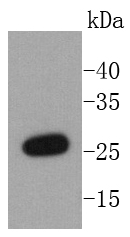Product Detail
Product NameNQO2 Rabbit mAb
Clone No.SC06-68
Host SpeciesRecombinant Rabbit
Clonality Monoclonal
PurificationProA affinity purified
ApplicationsWB
Species ReactivityHu, Ms, Rt
Immunogen Descrecombinant protein
ConjugateUnconjugated
Other NamesDHQV antibody
DIA6 antibody
EC 1.10.99.2 antibody
MGC94180 antibody
NAD(P)H dehydrogenase quinone 2 antibody
NAD(P)H menadione oxidoreductase 1 dioxin inducible 2 antibody
NAD(P)H menadione oxidoreductase 2 dioxin inducible antibody
NMOR2 antibody
NQO 2 antibody
NQO2 antibody
NQO2_HUMAN antibody
NRH dehydrogenase [quinone] 2 antibody
NRH dehydrogenase antibody
NRH:quinone oxidoreductase 2 antibody
OTTHUMP00000015948 antibody
OTTHUMP00000015949 antibody
OTTHUMP00000015953 antibody
Ox 2 antibody
Ox2 antibody
QR2 antibody
Quinone antibody
Quinone reductase 2 antibody
Ribosyldihydronicotinamide dehydrogenase [quinone] antibody
Ribosyldihydronicotinamide dehydrogenase antibody
Accession NoSwiss-Prot#:P16083
Uniprot
P16083
Gene ID
4835;
Calculated MW26 kDa
Formulation1*TBS (pH7.4), 1%BSA, 40%Glycerol. Preservative: 0.05% Sodium Azide.
StorageStore at -20˚C
Application Details
WB: 1:1,000-1:2,000
Western blot analysis of NQO2 on Hela cells lysates using anti-NQO2 antibody at 1/1,000 dilution.
NAD(P)H:quinone oxidoreductase 1 (NQO1) and NRH:quinone oxidoreductase (NQO2) are flavoproteins that catalyze the metabolic detoxification of quinones and their derivatives to hydroquinones. This detoxification process protects cells against quinone-induced oxidative stress, cytotoxicity and mutagenicity. NQO2 is a 231 amino acid protein and is 43 amino acids shorter than NQO1 at its C-terminus. NQO2 is an isozyme of NQO1 and transfers two electrons to a quinone, resulting in the formation of a hydroquinone product . The NQO2 gene is ubiquitously expressed and induced in response to TCDD. NQO2 has a higher level of expression in mouse liver and testis than NQO1, which is highly expressed in the heart. NQO2 has a different cofactor requirement than NQO1 and uses dihydronicotinamide riboside (NRH) rather than NAD(P)H as an electron donor. Unlike NQO1, NQO2 is resistant to typical inhibitors of NQO1 such as dicoumarol, Cibacron blue and phenindonee, but is inhibited by quercetin and benzo(a)pyrene. NQO2 contains a specific metal binding site, which is absent in NQO1 and several cis-elements including SP1 binding sites, CCAAT box, XRE and ARE, which are located at the NQO2 gene promoter.
If you have published an article using product 49011, please notify us so that we can cite your literature.



 Yes
Yes



